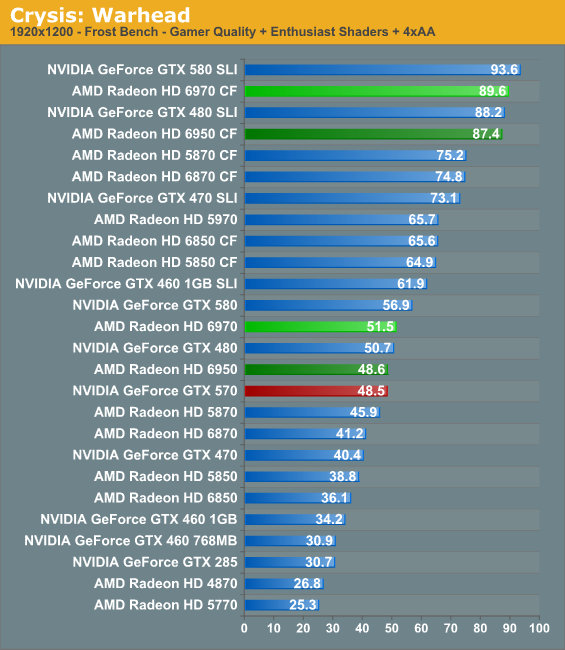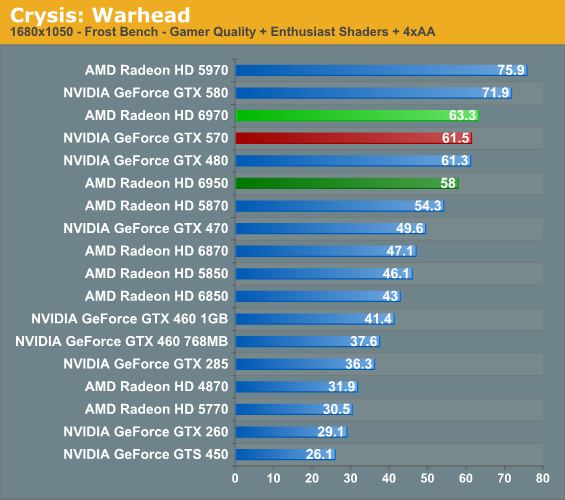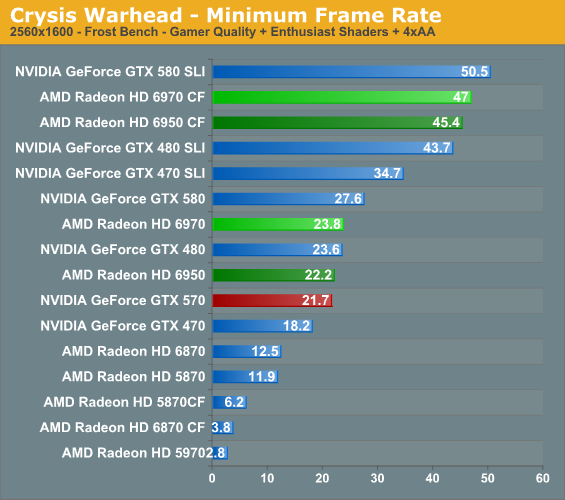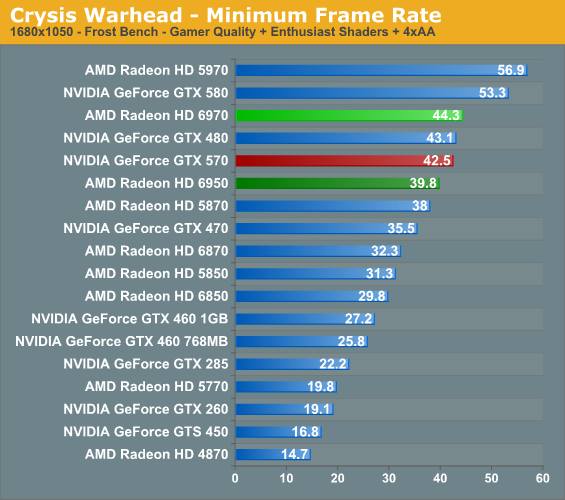AMD's Radeon HD 6970 & Radeon HD 6950: Paving The Future For AMD
by Ryan Smith on December 15, 2010 12:01 AM ESTCrysis: Warhead
Kicking things off as always is Crysis: Warhead, still one of the toughest game in our benchmark suite. Even 2 years since the release of the original Crysis, “but can it run Crysis?” is still an important question, and the answer continues to be “no.” While we’re closer than ever, full Enthusiast settings at a playable framerate is still beyond the grasp of a single card.



Crysis starts things off well for AMD. Keeping an eye on 2560 and 1920, not only does the 6970 start things off with a slight lead over NVIDIA’s GTX 570, but even the cheaper 6950 holds parity. In the case of the 6900 series it also hits a special milestone at 2560, being the first AMD single-GPU cards to surpass 30fps. This also gives us our first inkling of 6950 performance relative to 5870 performance – as expected the 6950 is faster, but at 5-10% not fantastically so. Crysis does push in excess of 2mil polygons/frame, but the 6900 series’ improvements are best suited for when tessellation is in use.
Meanwhile our CrossFire setups are unusually close, with barely 2fps separating the 6970CF and 6950CF. It’s unlikely we’re CPU limited at 2560, so we may be looking at being ROP-limited, as the ROPs are the only constant between the two cards.



With 2GB of RAM our AMD cards finally break out of the minimum framerate crash Crysis experiences with 1GB AMD cards. Our rankings are similar to our averages, with the 6970 taking a small lead while the 6950 holds close to the 570.










168 Comments
View All Comments
cyrusfox - Wednesday, December 15, 2010 - link
You should totally be able to do a 4X1 display, 2 DP and 2 DVI, as long as one of those DP dells also has a DVI input. That would get rid of the need for your usb-vga adapter.gimmeagdlaugh - Wednesday, December 15, 2010 - link
Not sure why AMD 6970 has green bar,while NV 580 has red bar...?
medi01 - Wednesday, December 15, 2010 - link
Also wondering. Did nVidia marketing guys called again?Ryan Smith - Wednesday, December 15, 2010 - link
I normally use green for new products. That's all there is to it.JimmiG - Wednesday, December 15, 2010 - link
Still don't like the idea of Powertune. Games with a high power load are the ones that fully utilize many parts of the GPU at the same time, while less power hungry games only utilize parts of it. So technically, the specifications are *wrong* as printed in the table on page one.The 6970 does *not* have 1536 stream processors at 880 MHz. Sure, it may have 1536 stream processors, and it may run at up to 880 MHz.. But not at the same time!
So if you fully utilize all 1536 processors, maybe it's a 700 MHz GPU.. or to put it another way, if you want the GPU to run at 880 MHz, you may only utilize, say 1200 stream processors.
cyrusfox - Wednesday, December 15, 2010 - link
I think Anand did a pretty good job of explaining at how it reasonably power throttles the card. Also as 3rd party board vendors will probably make work-arounds for people who abhor getting anything but the best performance(even at the cost of efficiency). I really don't think this is much of an issue, but a good development that is probably being driven by Fusion for Ontario, Zacate, and llano. Also only Metro 2033 triggered any reduction(850Mhz from 880Mhz). So your statement of a crippled GPU only holds for Furmark, nothing got handicapped to 700Mhz. Games are trying to efficiently use all the GPU has to offer, so I don't believe we will see many games at all trigger the use of powertune throttling.JimmiG - Wednesday, December 15, 2010 - link
Perhaps, but there's no telling what kind of load future DX11 games, combined with faster CPUs will put on the GPU. Programs like Furmark don't do anything unusual, they don't increase GPU clocks or voltages or anything like that - they just tell the GPU - "Draw this on the screen as fast as you can".It's the same dilemma overclockers face - Do I keep this higher overclock that causes the system to crash with stress tests but works fine with games and benchmarks? Or do I back down a few steps to guarantee 100% stability. IMO, no overclock is valid unless the system can last through the most rigorous stress tests without crashes, errors or thermal protection kicking in.
Also, having a card that throttles with games available today tells me that it's running way to close to the thermal limit. Overclocking in this case would have to be defined as simply disabling the protection to make the GPU always work at the advertised speed.
It's a lazy solution, what they should have done is go back to the drawing board until the GPU hits the desired performance target while staying within the thermal envelope. Prescott showed that you can't just keep adding stuff without any considerations for thermals or power usage.
AnnihilatorX - Wednesday, December 15, 2010 - link
Didn't you see you can increase the throttle threshold by 20% in Catalyst Control Centre. This means 300W until it throttles, which in a sense disables the PowerTune.Mr Perfect - Thursday, December 16, 2010 - link
On page eight Ryan mentions that Metro 2033 DID get throttled to 700MHz. The 850MHz number was reached by averaging the amount of time Metro was at 880MHz with the time it ran at 700MHz.Which is a prime example of why I hate averages in reviews. If you have a significantly better "best case", you can get away with a particularly bad "worst case" and end up smelling like roses.
fausto412 - Wednesday, December 15, 2010 - link
CPU's have been doing this for a while...and you are allowed to turn the feature off. AMD is giving you a range to go over.It will cut down on RMA's, Extend Reliability.